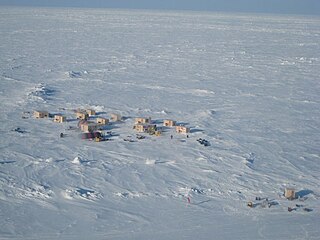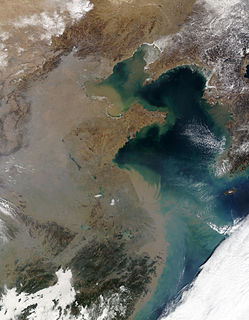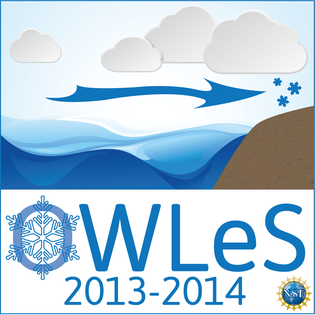 W
WThe Applied Physics Laboratory Ice Station 2007 (APLIS07) is a U.S. and Japanese laboratory dedicated to the study of global climate change, located about 300 kilometres (190 mi) south of the Arctic Circle, Alaska on the West Ridge of the University of Alaska Fairbanks campus.
 W
WThe Indian Ocean brown cloud or Asian brown cloud is a layer of air pollution that recurrently covers parts of South Asia, namely the northern Indian Ocean, India, and Pakistan. Viewed from satellite photos, the cloud appears as a giant brown stain hanging in the air over much of South Asia and the Indian Ocean every year between January and March, possibly also during earlier and later months. The term was coined in reports from the UNEP Indian Ocean Experiment (INDOEX).
 W
WThe Atmospheric Radiation Measurement Climate Research Facility is a United States Department of Energy scientific user facility for the study of global climate change by the national and international research community.
 W
WDoppler on Wheels is a fleet of X-band and C-band radar trucks maintained by the Center for Severe Weather Research (CSWR) in Boulder, Colorado, led by principal investigator Joshua Wurman, with the funding largely provided by the National Science Foundation (NSF). The DOW fleet and its associated Mobile Mesonet and Pod deployable weather stations are Lower Atmospheric Observing Facilities (LAOF) "National Facilities" supporting a wide variety NSF-sponsored research.
The Environmental Science Services Administration (ESSA) was a United States Federal executive agency created in 1965 as part of a reorganization of the United States Department of Commerce. Its mission was to unify and oversee the meteorological, climatological, hydrographic, and geodetic operations of the United States. It operated until 1970, when it was replaced by the new National Oceanic and Atmospheric Administration (NOAA).
 W
WThe Global Energy and Water cycle Exchanges project is an international research project and a core project of the World Climate Research Programme (WCRP).
 W
WThe Hurricane Rainband and Intensity Change Experiment (RAINEX) is a project to improve hurricane intensity forecasting via measuring interactions between rainbands and the eyewalls of tropical cyclones. The experiment was planned for the 2005 Atlantic hurricane season. This coincidence of RAINEX with the 2005 Atlantic hurricane season led to the study and exploration of infamous hurricanes Katrina, Ophelia, and Rita. Where Hurricane Katrina and Hurricane Rita would go on to cause major damage to the US Gulf coast, Hurricane Ophelia provided an interesting contrast to these powerful cyclones as it never developed greater than a category 1.
 W
WProject NIMROD was meteorological field study of severe thunderstorms and their damaging winds. It was conducted in the region of the Greater Chicago, Illinois, United States, from 15 May through 30 June 1978. Data collected were from single cell thunderstorms as well as mesoscale convective systems, such as bow echoes. Using Doppler weather radars and damage clues on the ground, the team studied mesocyclones, downbursts and gust fronts. NIMROD was the first time that microbursts, very localized strong downdrafts under thunderstorms, were detected which help improve airport and public safety by the development of systems like the Terminal Doppler Weather Radar and the Low-level windshear alert system.
 W
WThe Ontario Winter Lake-effect Systems (OWLeS) was a field project focused on three modes of lake-effect snow: Short-fetch, long-fetch, and downstream coastal and orographic effects. The project was conducted along Lake Ontario in the Great Lakes region and in the Finger Lakes region of upstate New York. OWLeS occurred in two field phases, one in December 2013 and another in January 2014. The project is a collaborative effort of nine universities and the Center for Severe Weather Research and is funded by the National Science Foundation (NSF).
 W
WProject Stormfury was an attempt to weaken tropical cyclones by flying aircraft into them and seeding with silver iodide. The project was run by the United States Government from 1962 to 1983. The hypothesis was that the silver iodide would cause supercooled water in the storm to freeze, disrupting the inner structure of the hurricane, and this led to seeding several Atlantic hurricanes. However, it was later shown that this hypothesis was incorrect. It was determined that most hurricanes do not contain enough supercooled water for cloud seeding to be effective. Additionally, researchers found that unseeded hurricanes often undergo the same structural changes that were expected from seeded hurricanes. This finding called Stormfury's successes into question, as the changes reported now had a natural explanation.
 W
WThe Scaled Composites Model 281 Proteus is a tandem-wing High-Altitude Long Endurance aircraft designed by Burt Rutan to investigate the use of aircraft as high altitude telecommunications relays. The Proteus is actually a multi-mission vehicle, able to carry various payloads on a ventral pylon.
 W
WThe Southern Hemisphere Auroral Radar Experiment (SHARE), started 1988, is an Antarctic research project designed to observe velocities and irregularities of electrical fields in the ionosphere and magnetosphere. SHARE is operated jointly by the University of Natal, Potchefstroom University, the British Antarctic Survey and Johns Hopkins University and operates out of British Halley Station, South African SANAE IV Station and Japanese Showa Station.
 W
WStratospheric Particle Injection for Climate Engineering was a United Kingdom government-funded climate engineering (geoengineering) research project that aimed to assess the feasibility of injecting particles into the stratosphere from a tethered balloon for the purposes of solar radiation management.
 W
WThe TOtable Tornado Observatory is a large, instrumented barrel-shaped device invented in 1979 by engineers Dr. Al Bedard and Carl Ramzy of the National Oceanic and Atmospheric Administration (NOAA) Environmental Technology Laboratory (ETL), and Dr. Howard Bluestein, meteorologist at the University of Oklahoma (OU). NOAA's objective was to place the TOTO directly in the path of a tornado, where it could, theoretically, record valuable information about the tornado's structure.
 W
WTWISTEX was a tornado research experiment that was founded and led by Tim Samaras of Bennett, Colorado, US. The experiment announced in 2015 that there were some plans for future operations, but no additional information has been announced since.
 W
WVertical Distribution of Ice in Arctic Clouds (VERDI) is the name of a German research project on the topic of Arctic clouds. Measurements within this project were conducted in April and May 2012 around Inuvik, Canada, organized by the University of Leipzig. The project aims at an improvement of knowledge about the effects of clouds in the Arctic climate system. The main question within VERDI is the distribution of ice crystals and liquid water droplets within the clouds. That distribution depends on various parameters, such as temperature and the cloud's life cycle.
 W
WThe Verification of the Origins of Rotation in Tornadoes Experiment or VORTEX are field experiments that study tornadoes. VORTEX1 was the first time scientists completely researched the entire evolution of a tornado with an array of instrumentation, enabling a greater understanding of the processes involved with tornadogenesis. A violent tornado near Union City, Oklahoma was documented in its entirety by chasers of the Tornado Intercept Project (TIP) in 1973 and visual observations led to advancement in understanding of tornado structure and life cycles. VORTEX2 utilized enhanced technology allowing scientists to improve forecasting capabilities to improve advanced warnings to residents. VORTEX2 sought to elucidate how tornadoes form, how long they last and why they last that long, and what causes them to dissipate.